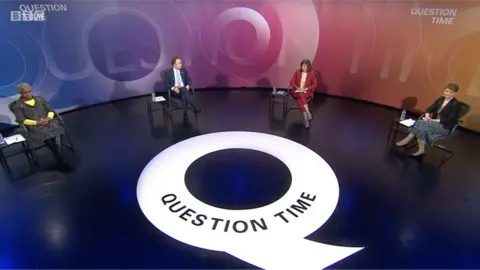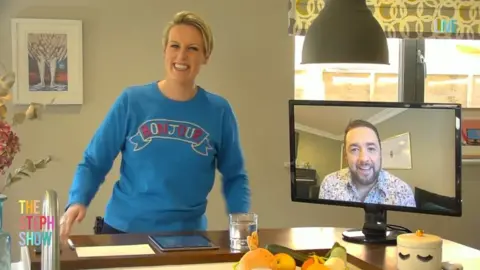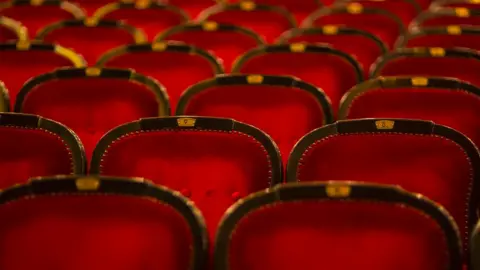TV in lockdown: How shows are coping without a studio audience
If somebody tells a joke, and nobody is around to hear it, was it actually funny?
That's the question facing TV producers at the moment as they try to keep their shows as lively as possible, despite not having a studio audience.
Lockdown restrictions have forced all programmes to film without their usual crowd - and there have been decidedly mixed results so far.
Some shows have been taken by surprise at how much more popular they are without an audience. But others are struggling to keep up their usual momentum.
"A studio audience brings a lot of energy and pace, and they're also markers for how we should be feeling at home," says Frances Taylor, commissioning editor for comedy and entertainment at The Radio Times. "Without them, a lot of programmes have a very different atmosphere."
Which, she adds, isn't necessarily a bad thing. "Question Time probably is serving better without an audience, because it feels less gladiatorial, less combative.
"So it's a calmer arena without the booing and clapping, it feels like a more measured programme. And for the factual political programmes, that's arguably an improvement."

Question Time's new format sees the socially-distanced panel take questions from viewers at home, rather than its studio audience.
The fact the panellist can then deliver their answer without heckling arguably removes some element of scrutiny - the audience's reaction often has the effect of holding an individual to account, as the speaker is forced to respond to it.
But many viewers and panellists feel not having an audience has improved the level of debate.
Former Today editor Roger Mosey said the show had been "revitalised", adding the speakers "no longer have to face a baying crowd of people seeking their own minute of fame".
After Question Time's first audience-free episode aired, Piers Morgan said: "I actually preferred it, it didn't have the bear pit element that it's become. I've done Question Time more than 20 times and instinctively you kind of treat it like theatre, you play to the audience, you go in for your applause line.
"But when they're not there, you actually have to be different, you can't play to the gallery. You have to only play to the people there. I learned more from [watching] that Question Time than any of the recent shows for a few years, it was interesting."
The BBC said live studio interaction and hearing from the general public are key parts of Question Time, but added it's pleased the programme has been able to make the new format work.
Comedy programmes, on the other hand, are finding things tougher.

When the success of a show depends on good jokes, the lack of an audience to laugh at them suddenly makes witty one-liners lose their zing.
Helen Lewis, who recently appeared on the first audience-free episode of Have I Got News For You, acknowledged the difficulties in an article for The Atlantic.
"Comedy without an audience is, by definition, less funny," she said. "Laughter is heightened when it's a collective experience. We laugh more in a club or an arena than we do watching the same comedian's Netflix special from our sofa.
"Nothing teaches you how to generate a laugh - or makes you more keen to get one - than ending a sentence and being greeted with the howling sound of absolute silence. As you perform, you begin to understand the underlying grammar of comedy - the order in which to reveal information, for example.
"Good stand-ups will use the audience as an editor, which helps them refine their material. For a television or radio producer, the audience also provides an instant judgment on each joke."

TV producers must be applauded for keeping such programmes on the air during such difficult circumstances. The writing, too, is just as strong as it's ever been. But without anyone to encourage laughter, the jokes can fall flat to the viewer at home.
Last year, researchers at University College London found viewers felt jokes were funnier when they were accompanied by the sound of others laughing.
"The laughter is influencing how funny the jokes seem and I think that's because laughter is a very important signal for humans. It always means something," said Sophie Scott, a professor of cognitive neuroscience, who led the research.
Some shows are thriving, others are struggling - but most seem to fall somewhere in the middle.
Channel 4's new lunchtime programme The Steph Show, fronted by Steph McGovern, has been largely praised by viewers and critics, even though it had been initially intended to feature a studio audience.
Instead, it launched during lockdown from McGovern's own living room, with automatically controlled cameras.
"This is not what we had planned," McGovern said in the opening episode. "It could be a bit rough round the edges but that's how I've been described for most of my career."
 Channel 4
Channel 4While recording without a studio audience may not be ideal, the series seems to be coping well under the circumstances.
Similarly, The Graham Norton Show on BBC One is able to survive without its audience because it isn't exclusively a comedy show - it can function as a straightforward interview programme if it has to, with its celebrity guests in their own homes.
It does, however, arguably lose some of its life and energy without a crowd - and it puts more pressure on the host.
"Graham Norton, in its normal format, thrives on that sparky punchiness of the dynamic between the guests, and there's a laughter and energy with that that comes from the audience," Taylor says.
"The new show is a lot calmer, a lot quieter. Entertainment programmes these days are generally quick quick quick, edits, noises, and actually, it's forced programmes like that to be innovative and different. I'm actually enjoying some elements of the new Graham Norton Show, but you've just got to see it as a different sort of programme."
 Getty Images
Getty ImagesShe notes: "It often depends on the skill of the presenter, and [Norton] is one of the best broadcasters in the country, same with Ant and Dec, they can make it work because they're so good."
It's difficult to quantify how audience-free formats are affecting viewing figures. Question Time's ratings have significantly increased, but that will have been influenced by other factors too - not least the show's earlier timeslot, the busy news agenda, and the fact most of us are stuck at home.
A captive audience has meant improved viewing figures across the board - a recent episode of Ant and Dec's Saturday Night Takeaway which filmed without an audience actually recorded the show's highest ever ratings of 9.5 million.
How long will this be the new normal? It's difficult to say, because even if lockdown measures were eased somewhat in the coming weeks, some form of social distancing could well remain in place - which presents problems for producers.
"If it lasts to the end of the year, then you think about programmes like Strictly," says Taylor. "In Germany they've been filming that without an audience, but would they do that here? There are a lot of questions that actually not only do the government not yet have the answers to, but TV producers don't have the answer to."
